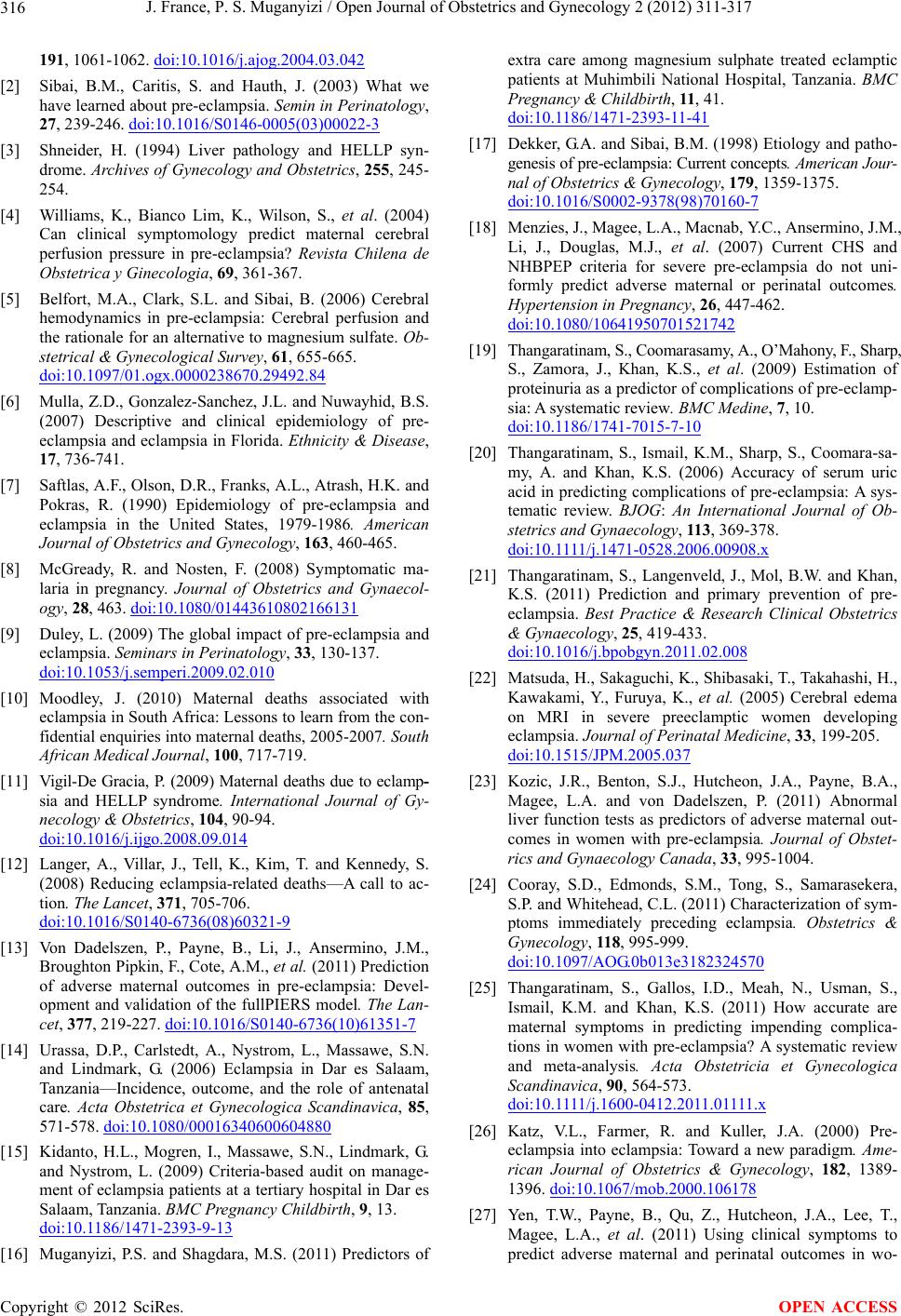
J. France, P. S. Muganyizi / Open Journal of Obstetrics and Gynecology 2 (2012) 311-317
316
191, 1061-1062. doi:10.1016/j.ajog.2004.03.042
[2] Sibai, B.M., Caritis, S. and Hauth, J. (2003) What we
have learned about pre-eclampsia. Semin in Perinatology,
27, 239-246. doi:10.1016/S0146-0005(03)00022-3
[3] Shneider, H. (1994) Liver pathology and HELLP syn-
drome. Archives of Gynecology and Obstetrics, 255, 245-
254.
[4] Williams, K., Bianco Lim, K., Wilson, S., et al. (2004)
Can clinical symptomology predict maternal cerebral
perfusion pressure in pre-eclampsia? Revista Chilena de
Obstetrica y Ginecologia, 69, 361-367.
[5] Belfort, M.A., Clark, S.L. and Sibai, B. (2006) Cerebral
hemodynamics in pre-eclampsia: Cerebral perfusion and
the rationale for an alternative to magnesium sulfate. Ob-
stetrical & Gynecological Survey, 61, 655-665.
doi:10.1097/01.ogx.0000238670.29492.84
[6] Mulla, Z.D., Gonzalez-Sanchez, J.L. and Nuwayhid, B.S.
(2007) Descriptive and clinical epidemiology of pre-
eclampsia and eclampsia in Florida. Ethnicity & Disease,
17, 736-741.
[7] Saftlas, A.F., Olson, D.R., Franks, A.L., Atrash, H.K. and
Pokras, R. (1990) Epidemiology of pre-eclampsia and
eclampsia in the United States, 1979-1986. American
Journal of Obstetrics and Gynecology, 163, 460-465.
[8] McGready, R. and Nosten, F. (2008) Symptomatic ma-
laria in pregnancy. Journal of Obstetrics and Gynaecol-
ogy, 28, 463. doi:10.1080/01443610802166131
[9] Duley, L. (2009) The global impact of pre-eclampsia and
eclampsia. Seminars in Perinatology, 33, 130-137.
doi:10.1053/j.semperi.2009.02.010
[10] Moodley, J. (2010) Maternal deaths associated with
eclampsia in South Africa: Lessons to learn from the con-
fidential enquiries into maternal deaths, 2005-2007. South
African Medical Journal, 100, 717-719.
[11] Vigil-De Gracia, P. (2009) Maternal deaths due to eclamp-
sia and HELLP syndrome. International Journal of Gy-
necology & Obstetrics, 104, 90-94.
doi:10.1016/j.ijgo.2008.09.014
[12] Langer, A., Villar, J., Tell, K., Kim, T. and Kennedy, S.
(2008) Reducing eclampsia-related deaths—A call to ac-
tion. The Lancet, 371, 705-706.
doi:10.1016/S0140-6736(08)60321-9
[13] Von Dadelszen, P., Payne, B., Li, J., Ansermino, J.M.,
Broughton Pipkin, F., Cote, A.M., et al. (2011) Prediction
of adverse maternal outcomes in pre-eclampsia: Devel-
opment and validation of the fullPIERS model. The Lan-
cet, 377, 219-227. doi:10.1016/S0140-6736(10)61351-7
[14] Urassa, D.P., Carlstedt, A., Nystrom, L., Massawe, S.N.
and Lindmark, G. (2006) Eclampsia in Dar es Salaam,
Tanzania—Incidence, outcome, and the role of antenatal
care. Acta Obstetrica et Gynecologica Scandinavica, 85,
571-578. doi:10.1080/00016340600604880
[15] Kidanto, H.L., Mogren, I., Massawe, S.N., Lindmark, G.
and Nystrom, L. (2009) Criteria-based audit on manage-
ment of eclampsia patients at a tertiary hospital in Dar es
Salaam, Tanzania. BMC Pregn an cy Childbirth, 9, 13.
doi:10.1186/1471-2393-9-13
[16] Muganyizi, P.S. and Shagdara, M.S. (2011) Predictors of
extra care among magnesium sulphate treated eclamptic
patients at Muhimbili National Hospital, Tanzania. BMC
Pregnancy & Childbirth, 11, 41.
doi:10.1186/1471-2393-11-41
[17] Dekker, G.A. and Sibai, B.M. (1998) Etiology and patho-
genesis of pre-eclampsia: Current concepts. American Jour-
nal of Obstetrics & Gynecology, 179, 1359-1375.
doi:10.1016/S0002-9378(98)70160-7
[18] Menzies, J., Magee, L.A., Macnab, Y.C., Ansermino, J.M.,
Li, J., Douglas, M.J., et al. (2007) Current CHS and
NHBPEP criteria for severe pre-eclampsia do not uni-
formly predict adverse maternal or perinatal outcomes.
Hypertension in Pregnancy, 26, 447-462.
doi:10.1080/10641950701521742
[19] Thangaratinam, S., Coomarasamy, A., O’Mahony, F., Sharp,
S., Zamora, J., Khan, K.S., et al. (2009) Estimation of
proteinuria as a predictor of complications of pre-eclamp-
sia: A systematic review. BMC Medine, 7, 10.
doi:10.1186/1741-7015-7-10
[20] Thangaratinam, S., Ismail, K.M., Sharp, S., Coomara-sa-
my, A. and Khan, K.S. (2006) Accuracy of serum uric
acid in predicting complications of pre-eclampsia: A sys-
tematic review. BJOG: An International Journal of Ob-
stetrics and Gynaecology, 11 3, 369-378.
doi:10.1111/j.1471-0528.2006.00908.x
[21] Thangaratinam, S., Langenveld, J., Mol, B.W. and Khan,
K.S. (2011) Prediction and primary prevention of pre-
eclampsia. Best Practice & Research Clinical Obstetrics
& Gynaecology, 25, 419-433.
doi:10.1016/j.bpobgyn.2011.02.008
[22] Matsuda, H., Sakaguchi, K., Shibasaki, T., Takahashi, H.,
Kawakami, Y., Furuya, K., et al. (2005) Cerebral edema
on MRI in severe preeclamptic women developing
eclampsia. Journal of Perinatal Medicine, 33, 199-205.
doi:10.1515/JPM.2005.037
[23] Kozic, J.R., Benton, S.J., Hutcheon, J.A., Payne, B.A.,
Magee, L.A. and von Dadelszen, P. (2011) Abnormal
liver function tests as predictors of adverse maternal out-
comes in women with pre-eclampsia. Journal of Obstet-
rics and Gynaecology Canada, 33, 995-1004.
[24] Cooray, S.D., Edmonds, S.M., Tong, S., Samarasekera,
S.P. and Whitehead, C.L. (2011) Characterization of sym-
ptoms immediately preceding eclampsia. Obstetrics &
Gynecology, 11 8, 995-999.
doi:10.1097/AOG.0b013e3182324570
[25] Thangaratinam, S., Gallos, I.D., Meah, N., Usman, S.,
Ismail, K.M. and Khan, K.S. (2011) How accurate are
maternal symptoms in predicting impending complica-
tions in women with pre-eclampsia? A systematic review
and meta-analysis. Acta Obstetricia et Gynecologica
Scandinavica, 90, 564-573.
doi:10.1111/j.1600-0412.2011.01111.x
[26] Katz, V.L., Farmer, R. and Kuller, J.A. (2000) Pre-
eclampsia into eclampsia: Toward a new paradigm. Ame-
rican Journal of Obstetrics & Gynecology, 182, 1389-
1396. doi:10.1067/mob.2000.106178
[27] Yen, T.W., Payne, B., Qu, Z., Hutcheon, J.A., Lee, T.,
Magee, L.A., et al. (2011) Using clinical symptoms to
predict adverse maternal and perinatal outcomes in wo-
Copyright © 2012 SciRes. OPEN ACCESS